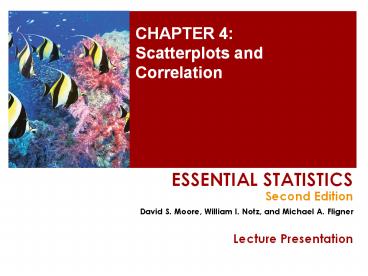CHAPTER%204:%20Scatterplots%20and%20Correlation - PowerPoint PPT Presentation
Title:
CHAPTER%204:%20Scatterplots%20and%20Correlation
Description:
CHAPTER 4: Scatterplots and Correlation ESSENTIAL STATISTICS Second Edition David S. Moore, William I. Notz, and Michael A. Fligner Lecture Presentation – PowerPoint PPT presentation
Number of Views:97
Avg rating:3.0/5.0
Title: CHAPTER%204:%20Scatterplots%20and%20Correlation
1
CHAPTER 4Scatterplots and Correlation
ESSENTIAL STATISTICS Second Edition David S.
Moore, William I. Notz, and Michael A.
Fligner Lecture Presentation
2
Chapter 4 Concepts
- Explanatory and Response Variables
- Displaying Relationships Scatterplots
- Interpreting Scatterplots
- Measuring Linear Association Correlation
- Facts About Correlation
3
Explanatory and Response Variables
Most statistical studies examine data on more
than one variable. In many of these settings, the
two variables play different roles.
Response Variable, Explanatory Variable A
response variable measures an outcome of a study.
An explanatory variable may help explain or
influence changes in a response variable.
Note In many studies, the goal is to show that
changes in one or more explanatory variables
actually cause changes in a response variable.
However, other explanatory-response relationships
dont involve direct causation.
4
Scatterplot
The most useful graph for displaying the
relationship between two quantitative variables
is a scatterplot.
4
A scatterplot shows the relationship between two
quantitative variables measured on the same
individuals. The values of one variable appear
on the horizontal axis, and the values of the
other variable appear on the vertical axis. Each
individual in the data appears as a point on the
graph.
How to Make a Scatterplot
- Decide which variable should go on each axis. If
a distinction exists, plot the explanatory
variable on the x-axis and the response variable
on the y-axis. - Label and scale your axes.
- Plot individual data values.
5
Scatterplot
Example Make a scatterplot of the relationship
between body weight and pack weight for a group
of hikers.
Body weight (lb) 120 187 109 103 131 165 158 116
Backpack weight (lb) 26 30 26 24 29 35 31 28
6
Interpreting Scatterplots
To interpret a scatterplot, follow the basic
strategy of data analysis from Chapters 1 and 2.
Look for patterns and important departures from
those patterns.
How to Examine a Scatterplot
- As in any graph of data, look for the overall
pattern and for striking departures from that
pattern. - You can describe the overall pattern of a
scatterplot by the direction, form, and strength
of the relationship. - An important kind of departure is an outlier, an
individual value that falls outside the overall
pattern of the relationship.
7
Interpreting Scatterplots
Two variables have a positive association when
as one variable decreases, the other variable
also decreases and vice versa. In statistics, a
perfect positive correlation is represented by
the value 1.00Two variables have a negative
association when one variable increases as the
other decreases, and vice versa. In statistics, a
perfect negative correlation is represented by
the value -1.00
8
Interpreting Scatterplots
- There is a moderately strong, positive, linear
relationship between body weight and pack weight. - It appears that lighter hikers are carrying
lighter backpacks.
9
Measuring Linear Association
- A scatterplot displays the strength, direction,
and form of the relationship between two
quantitative variables.
- The correlation r measures the strength of the
linear relationship between two quantitative
variables. - r is always a number between -1 and 1.
- r gt 0 indicates a positive association.
- r lt 0 indicates a negative association.
- Values of r near 0 indicate a very weak linear
relationship. - The strength of the linear relationship increases
as r moves away from 0 toward -1 or 1. - The extreme values r -1 and r 1 occur only in
the case of a perfect linear relationship.
10
Facts About Correlation
- Correlation makes no distinction between
explanatory and response variables. - r has no units and does not change when we
change the units of measurement of x, y, or
both. - Positive r indicates positive association
between the variables, and negative r indicates
negative association. - The correlation r is always a number between -1
and 1.
- Cautions
- Correlation requires that both variables be
quantitative. - Correlation does not describe curved
relationships between variables, no matter how
strong the relationship is. - Correlation is not resistant. r is strongly
affected by a few outlying observations. - Correlation is not a complete summary of
two-variable data.
11
Correlation
12
Chapter 4 Objectives Review
- Define explanatory and response variables
- Construct and interpret scatterplots
- Calculate and interpret correlation
- Describe facts about correlation































